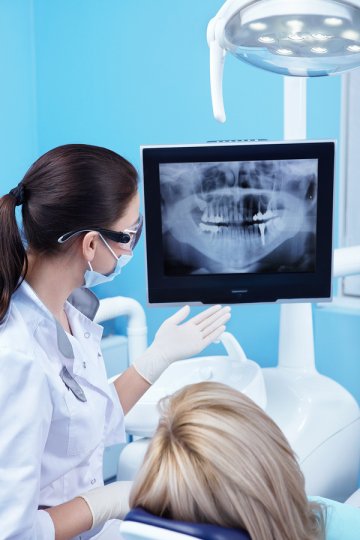-
Important Facts About Dental Implants
If you’re missing one or more teeth, you need a viable tooth replacement option to protect and restore your smile. Whether your tooth loss is the result of an injury, disease, or decay, dental implants may be right for you.
Dental implants are comprised of three parts—a post, an abutment, and a crown. The titanium post is implanted into your jawbone to replicate the root of your missing tooth. The post serves as a stable anchor for the abutment, which is screwed on top. The final piece is a natural-looking, enamel-colored crown, which is crafted to match the color and size of your natural teeth. The crown adheres to the abutment, restoring your smile, speech, and chewing capabilities in the process.
Could dental implants be the right way to fill the gap in your smile? Consider these important facts about dental implants to help you make the best decision for your oral health.
Continue reading “Important Facts About Dental Implants”
-
Stress-Related Facial and Jaw Pain During the Pandemic
The COVID-19 pandemic has had far-reaching consequences on people’s lives all over the world. Schools and businesses have closed, leaving young families cooped up at home where they’re inundated with a steady stream of apocalyptic news. Many workers have lost their jobs or been asked to work from home under trying conditions. Grocery store shelves have run bare, making it difficult to find essentials. Healthcare professionals have become the frontline workers in this fight against a new, unfamiliar virus. And just about everyone has worried about what would happen if their friends and family became ill with the disease.
Continue reading “Stress-Related Facial and Jaw Pain During the Pandemic”
-
Is it Safe to Visit the Dentist During COVID-19?
By now, everyone knows the basic precautions to slow the spread of the coronavirus—wear a mask, stand at least six feet apart from others, and avoid touching your face. So it’s logical to wonder—is it safe to visit the dentist during COVID-19? After all, this is a setting where you sit face-to-face with a medical practitioner, maskless and open-mouthed for an extended period of time.
Continue reading “Is it Safe to Visit the Dentist During COVID-19?”
-
How Smiling Affects Your Health
Your smile is one of the first things people notice about you. But smiling does far more than just make a good first impression—it can even impact your mental, physical, and social health. Here’s why it’s good to smile as often as you can.
How Smiling Affects Your Mental Health
Continue reading “How Smiling Affects Your Health”
-
How to Care for Your Smile During the Holidays
It’s easy to neglect your mouth during the hectic holiday season, but oral care is extra important this time of year. After all, with sugary snacks readily available and stress levels at their peak, your teeth and gums need all the attention they can get. Here’s how to care for your smile during the holidays.
Continue reading “How to Care for Your Smile During the Holidays”
-
Is Laser Dentistry Really Pain Free?
Most people would advise against sticking sharp metal things in your mouth, but then dentists come at you with a noisy metal drill and that’s supposed to be normal? No wonder people are afraid of going to the dentist when many dental procedures require anesthesia injections, stitches, and lots of recovery time. Fortunately, there is a new game in town that is helping highly skilled dentists in St. Louis take the “Ouch!” out of dental visits. Laser dentistry is a fast and effective method that uses heat and light to perform a wide variety of dental procedures. Most importantly, laser dentistry is virtually pain-free!
-
4 Tips to Save Time and Money at the Dentist
If you are one of the many people who have shied away from visiting the dentist because of time or money issues, you are definitely not alone. The huge cost of dental care can create financial hardships and take up countless sick days, but there are several ways to reduce your dental costs. Here are 4 tips that will help you save a lot of time and money on your next dental visit.
Continue reading “4 Tips to Save Time and Money at the Dentist” -
How 3-D Imaging Will Change Dentistry Forever
Typical dental x-rays can be a tedious and uncomfortable process. Numerous individual images are required to cover the entire mouth, which allows for too much cranial exposure to radiation. Also, traditional x-rays only focus on your teeth with no way to enhance the images, making it almost impossible to study the surrounding bone structure, bone density, tissues, and nerves for diagnostic purposes. But times are changing and the newest advances in 3-D imaging and digital technology are taking the dental industry by storm. Here are just a few of the remarkable ways 3-D dentistry is changing the way family dentists in St. Louis take care of your teeth.
Continue reading “How 3-D Imaging Will Change Dentistry Forever” -
What You Should Know Before a Root Canal
At your last dental visit, your dentist uttered two words that many people fear: root canal. While the procedure will eliminate your lingering tooth pain and hopefully reduce your immense sensitivity to hot and cold, the very idea of a root canal procedure can be a bit frightening. Here is a helpful guide that covers the most important things you should know before getting root canal therapy.

What exactly is a root canal?
When the blood or nerve supply of a tooth, also known as the pulp, is infected, root canal therapy is necessary to remove the infected tissue. Unfortunately, a root canal cannot save the tooth, but by preserving its natural structure, you will be able to chew food and speak properly.
What are some of the symptoms?
There are several signs that you may need a root canal procedure, including:
- Lingering or spontaneous pain in response to hot or cold drink
- Positional pain that is worse when you lay down, stand up suddenly, or run in place
- A white, yellow, or red pimple-looking blister on your gum
- An abscess, which will show up on an x-ray
- Pain in your jaw, ear, or surrounding teeth
Why is root canal therapy needed?
If an infection in the pulp of a tooth spreads to the underlying root canal system, it can lead to an abscess, which is an inflamed pus-filled pocket that causes swelling around the tooth. If a root canal is not done, the infection may spread to other areas of the face, you may suffer bone loss around the tip of the root, or the tooth may have to be extracted.
What does the procedure entail?
During root canal therapy, a dentist will remove the inflamed or infected pulp and carefully clean out and shape the inside of the tooth. Then, they will fill and seal the space to prevent further infection. The final step is for the dentist to place a crown on the tooth to protect its structural integrity. After a root canal procedure is completed, your tooth will function like any other tooth.
Is the procedure painful?
No, there should not be any root canal pain. With the use of a local anesthetic, the procedure should be no different than if you were having an ordinary filling done. Afterwards, you may feel a bit sore, but that will diminish over time.
How long will the root canal procedure take?
A root canal is a time-consuming procedure that often involves two or more visits to your dentist. The first appointment may be quite long as the dentist needs to remove the infected tissue and allow any abscesses to drain. Once the tooth is closed and shaped for filling, a temporary cap is put in and the tooth is left to settle. At the next appointment, the tooth is checked and if all is clear, it is permanently filled and capped.
Is any special care necessary after treatment?
Care instructions will be given out after each appointment, but good oral hygiene and regular dental visits are essential to ensuring the best results.
If you are experiencing tooth pain, don’t suffer in silence! Instead, utilize the knowledge and expertise of the West County Dental team in St. Louis, MO to help you find relief.
-
4 Ways Technology Has Improved Your Visit to the Dentist
A dentist appointment may not be your idea of a good time, but taking care of your teeth is your number one ticket to lifelong oral health. Fortunately, dental visits are not what they used to be! Technology has revolutionized the face of dentistry as we know it by helping St. Louis dentists find new ways to reduce tooth pain and create faster, safer, and more comfortable dental procedures. From crowns in a day to laser dentistry, here are 4 ways technology is taking the fear out of going to the dentist:
No more pain!
If your fear of the dentist chair has prevented you from dealing with your tooth pain, then your day has come! Laser dentistry is virtually painless and can be used in a wide variety of dental procedures. The Solea system, for example, is a CO 2 dental laser that uses a unique wavelength guided by sophisticated computers to work on both hard and soft tissues. The resulting procedure is blood-free and anesthesia-free, and there are no needles, scary-looking drills, or bone-chilling noises. Best of all, you can go right back to work without the lingering numbing affects that often cause embarrassing drooling and slurred speech.
Instant results
In the past, those suffering from damaged, broken, or missing teeth needed numerous trips to the dentist, countless injections, and days or months spent recovering between procedures in order to achieve the results they were after. However, the latest advances in 3D imaging and crown printing have made effective same day dental procedures a reality. Using CAD-CAM (Computer Aided Design-Computer Aided Manufacturing) technology, a non-invasive 3D scanner captures an image of your damaged teeth and an on-site milling device prints a perfect match within minutes. No temporary crowns, no messy impressions, and more of your natural tooth saved, all thanks to technology.

Faster, safer diagnoses
X-rays have always been an essential tool for diagnosing conditions of your teeth and gums, but traditional x-rays take time to create and expose patients to dangerous radiation. Modern digital X-rays have streamlined the diagnostic process. Since they immediately appear on computer screens, they can be digitally transferred to allow for faster communication between dentist and patient or enhanced for a more accurate diagnosis. Digital x-rays also provide greater comfort than traditional x-rays and reduce radiation exposure by 80-90%.
Interactive treatments
Have you always wondered exactly what the dentist sees when they look in your mouth? Well, now you can see for yourself with an intra-oral camera. This small device allows you to view the inside of your mouth in real time, giving the dentist an opportunity to further examine causes of tooth pain and discuss with you recommended dental procedures. The camera is also a great tool for pointing out where to focus on brushing, which allows you to maximize your dental hygiene routine.
When it comes to cutting-edge technology and effective dental procedures, the experienced team at West County Dental is the best in St. Louis, MO. We always stay ahead of the latest tools and techniques to bring you specialized dental care and fast, comfortable results.
RECENT POSTS
categories
- Uncategorized
- crowns
- dental veneers
- dentists
- full service dental practice
- porcelain veneers
- same day crowns
- Dental Cosmetic Surgery
- Dental Implants
- Dentistry
- Dentist Review
- Laser Dentistry
- Root Canal
- Sedation Dentistry
- Dentures
- Cleanings
- Teeth Whitening
- Abscessed Teeth
- Cosmetic Dentistry
- Infographic
- Cavities
- Sealants
- Gum Recession
- Periodontal Disease
- Dental Health
- Family Dentistry
- Dental Emergency
- Invisalign
- Filling
- Same Day Dental Procedures
- Gum disease
- Sleep Apnea
Archives
2022
2021
- December (2)
- November (1)
- October (3)
- September (2)
- August (2)
- July (2)
- June (2)
- May (2)
- April (2)
- March (2)
- January (2)
2020
2016
2015
- December (4)
- November (3)
- October (3)
- September (4)
- August (4)
- July (4)
- June (4)
- May (3)
- April (3)
- March (4)
- February (5)
- January (6)

